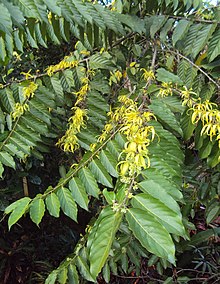Cananga
Appearance
| Cananga | |
|---|---|

| |
| Cananga odorata, leaves and flowers | |
| Scientific classification | |
| Kingdom: | Plantae |
| Clade: | Tracheophytes |
| Clade: | Angiosperms |
| Clade: | Magnoliids |
| Order: | Magnoliales |
| Family: | Annonaceae |
| Subfamily: | Ambavioideae |
| Genus: | Cananga (DC.) Hook.f. & Thomson, nom. cons.[1] |
Cananga is a small genus of trees in the family Annonaceae. One of its species, Cananga odorata, is important as the source of the perfume ylang-ylang.[2] Two species are recognized:[3]
- Cananga brandisiana (Pierre) Saff., syn. Cananga latifolia (Hook.f. & Thomson) Finet & Gagnep.
- Cananga odorata (Lam.) Hook.f. & Thomson
Cananga latifolia is listed as a separate species in some sources,[4] but the basionym, Unona latifolia Hook.f. & Thomson, is a later homonym of Unona latifolia Dunal and so is not an acceptable name. Unona brandisiana was explicitly proposed as a replacement name.[3]
References
- ^ "Cananga (DC.) Hook.f. & Thomson", IPNI Plant Names, International Plant Names Index, retrieved 2015-08-28
- ^ "Ylang-ylang", Encyclopaedia Britannica online, retrieved 2015-08-28
- ^ a b Turner, I.M.; Veldkamp, J.F. (2009), "A History of Cananga (Annonaceae)", The Gardens' Bulletin Singapore, 61 (1): 189–204, retrieved 2015-06-28
{{citation}}: Unknown parameter|lastauthoramp=ignored (|name-list-style=suggested) (help) - ^ "Cananga", The Plant List 1.1, retrieved 2015-08-28
